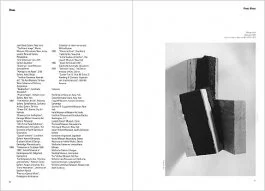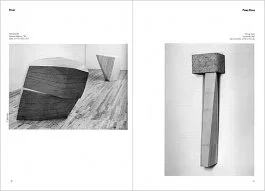Halal
Michael Gitlin
by Adachiara Zevi
The critical debate around the work of Michael Gitlin is centered essentially on a relation of continuity-confrontation the work has established with Minimalism.
Born in South Africa in 1943, Gitlin moved to Israel in 1948, the very year of the declaration of independence of the Jewish State. There he studied painting at the Bezalel Academy in Jerusalem and, at the same time, art and literature at Hebrew University. When he moved to the United States in 1970 to attend Pratt Institute in New York, Minimalism - still the dominant trend - had just run its course: just after getting established with the exhibition “Primary Structures”, held in 1966 at the Jewish Museum, Minimalism had already given birth to Conceptual Art (announced by the “Paragraphs” promulgated by Sol Le Witt in 1967), shown with great clamor in 1970 in the exhibition “Information” at the MoMA, to Land Art, and finally to ‘process art’ or ‘eccentric abstraction’, which questioned the assertivity of Minimalism through the use of organic, malleable and perishable materials. Gitlin said: “There was a sense of restriction regarding sculpture which related to how the Minimalists saw their object-making. Personal touch was taboo. Reference to anything but the purist Platonic concept was frowned upon. The system was hermetic”. By saying so, he shares post-Minimalist issues but his artistic outcome does not coincide with any one of the above mentioned contexts. “From my parents I absorbed European values and this, together with my Israeli education, prepared me for my American experience.
I am torn between the European and American dichotomies”, this is the motivation he brings forward. In Israel, in fact, he had studied under the guidance of teachers exiled from Europe, whose work was close to a School of Paris kind of abstraction. The peculiarity of Gitlin’s work lies exactly in the alternation or combination of ‘European’ and ‘American’ issues, which were in those years antithetic and irreconciliable. “Not the least of the qualities to be found in the work of Michael Gitlin is that it embraces the accumulation of contemporary art’s formal experiences and gives them intelligence, dimension and measure”. This acute observation was made by Marcelin Pleynet, the only one who did not settle the analysis of the artist’s work around its relationship with Minimalism. When Gitlin explains, “My generation had to refer to Pre-Minimalist work. We went back to the Modernist tradition”, he underlines a crucial point: the European-American dichotomy coincided in those years with that between Minimalism and Modernism. The ‘specific objects’ theorized and produced by Donald Judd in 1965 - aseptic, self-referential, industrial, serially or proportionally proliferating - constitute the point of arrival of the battle against illusionism and anthropomorphism already undertaken by the Abstract-expressionist generation, by artists like Still, Rothko and Newman but especially Stella (starting in 1958), who points out: “The basis of the conception of European geometric painting is balance. You make something in a corner and you balance it with something in another corner. The new painting can be characterized as symmetric, but we are using symmetry in a non-relational way”, which can be seen in the paintings with black stripes he was creating in those years. Talking about his masters, Gitlin insists they had a “formal approach to painting affected by Clement Greenberg’s precepts”. It was indeed Greenberg himself, in key texts such as “American Type Painting” of 1955 and “Modernist Painting” of 1961, who decided that the emancipation of American art passed through the use of the large format, the abolition of every form of illusive tridimensionality, of the frame, and of tonal values - elements which could all be found in the Cubist works. In this framework Greenberg then promoted Pollock, Still, Newman and Rothko while excommunicating de Kooning, Kline, Motherwell and others, regarded as late Cubists. When Gitlin, referring to what is most significant in American art for him, mentions “the sublime, elitist cultural pursuit represented by Newman, Rothko, Pollock, Kline and de Kooning”, he mixes two souls which cohabit inappropriately under the label of Abstract Expressionism, those which Harold Rosenberg distinguished instead as ‘action painting’ and ‘painting of idea’s idea’. We are assuming here that especially in his early works, when there was the strongest push to oppose Minimalism, Gitlin referred to artists like Pollock, Newman and Rothko, exactly those elected by the Minimalists as their predecessors.
“I believe that Pollock is at the origin of the large format, of the surface unity and of the simplicity that are present in every work of quality today ... In the paintings of Pollock, Rothko, Still and Newman the rectangle is emphasized. The elements inside the rectangle are broad and simple and correspond closely to the rectangle. The parts are few and so subordinate to the unity as not to be parts in an ordinary sense”. We can verify Judd’s theses on the works Gitlin was making around 1974-75 when he showed, not by chance, at the Betty Parsons Gallery, that same gallery which, after Peggy Guggenheim returned to Europe in 1947, had taken up her heritage picking up Pollock, Rothko, Still, but especially Newman as artistic consultant. “4’x8’ Series” is a series of works which consists of plywood sheets of standard measure made even more uniform by painting them black, something which certainly is a call back to the last stage of Rothko and Reinhardt and to Newman’s “Stations of the Cross”.
Gitlin’s action was implanted on such severe premises; he was ready to reintroduce the “personal touch”, to “transmit energy through the use of a tool”. Following previously drawn lines he split those sheets with an axe, then removing and relocating the cut-off parts in space. When he maintains that, thanks to those irregular borders, it is not possible “to restore the components and reconstitute the original unity”, Gitlin considers just the physical unity of the whole as irremediably compromised, however overlooking the conceptual and visual possibility to reconstruct it. Just a few hints about these works. “Hacking at the wood was like action-painting. I needed something very physical”. If Gitlin admires in Pollock the ability to combine “energy and abandon based on an absolute grid-like logic”, he takes up his physical involvement, his controlled rhythm and, in the chipped edges of the tears, his manuality. The interruption of the chromatic unity made by a contrasting crack can not moreover but recall what Newman had done with his ‘zip’ in a monochromatic field. And again, the use of standard sizes recalls the obstinacy with which Mel Bochner, over an entire year (1969), measured the space using sheets of the same standard size, 36 x 48 inches. Finally, the opportunity offered to the viewer to go backwards over the constructive process of the work brings one back to the conceptual synthesis between faraway times and spaces carried out by Smithson’s “Sites” - “Non Sites” as well as by the removals that document the ‘splittings’ of Gordon Matta-Clark. Though these works challenge the Minimalist tridimensionality (through the resumption of the bidimensional support, of frontal vision, of the figure-ground dialectics with walls, floor and their joinings), they adopt its uniform and orthogonal format, as well as repetition and serial sequence. With the force of a methodological declaration, to be stubbornly reasserted. This first stage of Gitlin’s work can recall, in its ambiguity between painting and sculpture, Carl Andre’s ‘sculpture-place’, as well as the dialogue Richard Serra established, in his 1969 “Props” series, between elements facing each other on the wall and on the floor. We could go further on to note that Andre’s and Stella’s references belong to the field of painting, to the stripe paintings of Stella and to the ‘dripping’ of Pollock. The principle of subtraction continued to guide Gitlin’s course up until 1980, even if as time passed the basic unit became more solid, more sculptural, replacing the sheets of plywood with blocks of wood, exposing a rough and corrugated surface to the black paint.
It is however guaranteed for the viewer the possibility to retrace the constructive process of the work. Three factors determined a turning point in Gitlin’s work around 1982: the substitution of the principle of accumulation for that of subtraction; the impossibility of going back to the genesis of a work that was now complex and lacking projectuality; and finally color, in all ranges, that was no longer hiding and unifying the material, but was rather transforming itself, mixed with plaster and sawdust, into color-matter, joining the pieces of raw wood. “Blue Focus”, “Grey Cast”, “Spatial Twist”, “Displaced” are just some works from a fruitful season that lasted until the beginning of the 90’s. Blocks of wood - cut with an axe with careless disregard for right angled lines- freely join, get entangled and layered, twist, wind round in spirals, stretch out from the wall while at the same time remaining precariously tied to it. The continuity with the preceding works is attested by the dialectics between surface and space, between painting and sculpture. It is not by chance that Gitlin, during these years, accompanies his sculpture with drawings. The same broken curves, spirals, zig-zags are traced on paper using pastel, oil, charcoal, challenging the ground, where mistakes and reconsiderations remain visible. Gitlin points out that these are not preliminary drawings for sculpture but rather a parallel process, on the plane and in the space, searching for new formal aggregations. In his works of the 70s Gitlin retrieved the painterly experience of Abstract Expressionism against the Minimalist tridimensionality, but it is only in this new cycle that he returns, announced, to the European tradition, even if he does that through the sculpture of David Smith. In fact, when he states “I am inclined towards the compositive, relational and hierarchical aspect in sculpture”, he is just claiming those aspects of Modernism against which painters like Johns and Stella and then sculptors like Judd, Andre, LeWitt had fought. If Gitlin in fact feels “connected to Cubist ideas in the way that they are transmitted through David Smith’s work”, that is “from within a non-objective context”, he is also fascinated by the “additive method” employed by the Constructivists, as well as by their “utopian ideas”, admitting the suggestion of Tatlin’s “Counter Reliefs” in “Broken Infinity” of 1988, a serpentine made of wooden beams winding through the Bonn Kunstverein, which delineates the shape of mathematic infinity. But there is more. In these works Gitlin does not just infringe the formal simplicity invoked by Robert Morris in “Notes on Sculpture”, but - freely joining parts, often in circular or spiral configurations- he again brings forward a model of organic and progressive development, antithetic to that of zero growth, of stationary and motionless time, of entropy, invoked by Smithson for those inert and indifferentiated structures whose law of proliferation takes instead from the world of physics and mathematics. And the attention of critics keeps insistently going back to this anthropomorphic aspect of Gitlin’s sculptures. Although they seem “pure sculptures”, observes Yigal Zalmona, they are “abstract structures of anthropological, if not to say anthropomorphic, significance”. Building on such titles as “Sentinel”, “Green Open Enclosure”, to which one could add the various hypotheses of “Shelter”, Steven Henry Madoff speaks of the absent body which is implied by these stretched out structures. If Maia Damianovic maintains that “the sculptural figures of Gitlin proceed from indivisible ideality to multiple individuality”, Amnon Barzel, grouping six Israeli sculptors under the denomination “existential sculpture”, as opposed to “epistemological”, speaks of “feelings of limb amputation, danger, and aggression”. In the exhibition curated by Barzel there was also Nahum Tevet, an artist Gitlin loves and admires. Tevet’s precarious aggregations hanging from the wall at first glance seem similar to works Gitlin made after 1982. But taking a closer look we can see a difference, consisting mainly in the constructive matrix of those aggregations. If Gitlin actually remains always faithful to a language of abstract and self-referential forms, Tevet - since his beginnings in the early 70s - uses the ready-made combining, almost as if they were modules, tables, chairs, benches, in free and unstable configurations which privilege (as in Gitlin) the wall as a support. “I’ve often thought about why this dependence on the wall continues as a motif throughout my work. I think it has to do with the fragility of the pieces and the fact that they need a basic structure. The wall is there and it does not share the exact space I stand on”, Gitlin admits, worried. But in works like “Siamese Addiction” or “Tributary” of 1991, exhibited today in Rome, that “psychological weakness” appears finally defeated. A sculptor at last, no longer winking at painting, Gitlin places masses of wood on the ground, wood being no longer hidden by color. But it is not a matter of abjuration. Still composed of parts (albeit in reduced numbers and distinguished only by the nature of wood), these sculptures, far from finding a stable position, are placed precariously on inclined planes which delineate their profiles, imposing on the viewer - who is now living their same space - a moving point of view.
1. E.A. King, “A Conversation with Michael Gitlin”, cat. Michael Gitlin 1982-1989, Carnegie Mellon Art Gallery, Pittsburgh, 1989.
2. E.A. King, op.cit.
3. M. Pleynet, cat. Michael Gitlin Works 1974-1980, Städtische Galerie, Erlangen, 1980.
4. E.A. King, op.cit.
5. E.A. King, op.cit.
6. D. Judd, “Specific Obiects”, in Writings 1975-1986, van Abbemuseum, Eindhoven, 1987.
7. E.A. King, op.cit.
8. Y. Zalmona, “Co-existence of Opposites”, cat. Michael Gitlin 1982-1989, Carnegie-Mellon Art Gallery, Pittsburgh, 1989.
9. S.H. Madoff, “A Space Opens in the Work of Michael Gitlin”, cat. Michael Gitlin Sculptures Drawings 1982-1985, Exit Art, New York, 1985.
10. M. Damianovic, “Silence and Reprieve”, cat. Michael Gitlin, MUHKA, Antwerp, 1991.
11. A. Barzel, Six Sculptors, Kibbutz Art Gallery, Tel Aviv, 1982.
12. E.A. King, op.cit.


